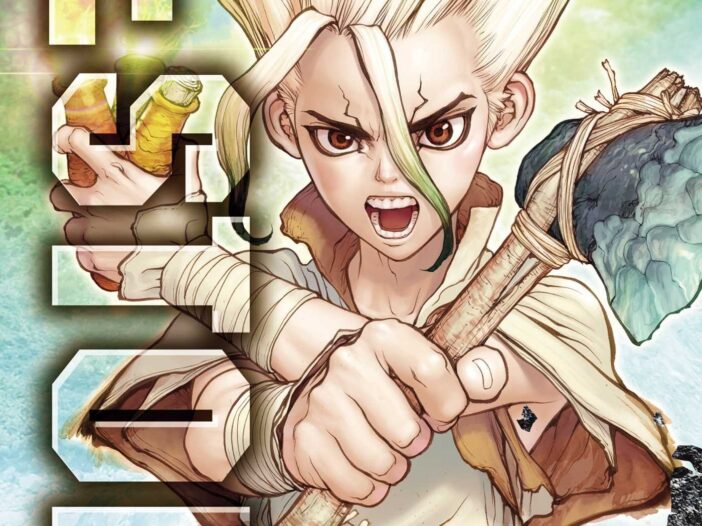
AnimeNYC: A Peek Behind the Scenes of ‘Dr. Stone’

“It’s like MacGyver crossed with Inspector Gadget, with some cool art.”
That’s how the editor of Dr. Stone described this series, a Shonen Jump manga about a genius who must re-create all of modern technology after every human on earth is turned to stone for over 3,000 years.
As in all shonen manga, the saviors of humankind are a group of teenagers, and fortunately one of them, Senku, is a science genius. As soon as he emerges from his stone cocoon, Senku gets busy using bits and pieces of nature to re-create wine, soap, gunpowder, and even a cell phone.
ADVERTISEMENT
ADVERTISEMENT
Publisher Viz Media brought the creators of Dr. Stone, writer Riichiro Inagaki and artist Boichi, to AnimeNYC in November, and they appeared at two panels, with Viz editor Urian Brown asking the questions. Here are some edited highlights from those Q&A sessions—and if you want to know more, check out Lori Henderson’s review of Dr. Stone!

[Editor’s note: Manga professionals use the honorific “sensei,” or teacher, when addressing or referring to manga creators.]
What is the process like creating Dr. Stone?
Inagaki: I start out with what’s called a storyboard, instead of just textual writing. Then I pass it on to my editor, he looks it over then it gets passed over to Boichi-sensei.
It’s probably a little more work than that sounds like.
Inagaki: Well, mine doesn’t require a whole lot of drawing. If you all just imagine a rough sketch on the back of a napkin versus a finished, completed project, you can tell who has a lot of work.
Boichi: Inagaki-sensei does all the important things, so after I receive his storyboard, I just do it quickly and then I go eat.

Were you interested in science before starting this series?
Inagaki: Since I was a kid I have liked science and math, so I thought I would end up in that field, but I clearly became a manga story writer instead.
Boichi: I was always interested in science fiction, since I was little. One of my favorite authors is Arthur C. Clarke. I know he studied physics and mathematics, so I followed his steps.
Do you have a favorite real-life inventor or scientist?
Inagaki: I would say Einstein, but putting Einstein aside—this is someone I always have to mention—there is a chemical called gibberellin that causes seedless grapes, and that was invented by Teijiro Yabuta. And I always have to mention him because he is my wife’s grandfather!
Boichi: I have so many favorite scientists! Among them are Isaac Newton, Albert Einstein, Richard Dawson, Stephen Hawking, Desmond Morris, and Carl Sagan. Carl Sagan introduced science to the public as something warm, not cold. I try for the same thing when I draw Senku—I try to inject this warm soul into him.

How different is writing for a series like Dr. Stone as opposed to something like Eyeshield 21?
Inagaki: No matter how interesting I want to make a sports manga, unfortunately there are rules for the sports, so I am confined by those. But in the case of Dr. Stone, pretty much the sky is the limit! There are the rules of science of course. The challenge is to be always researching the rules of science, but the fun part is I can write whatever I want to write and at the end of the day I’m having fun.
They have reinvented so many things in Dr. Stone—ramen, phones, record players—but no one has reinvented anime. Will that happen at some point?
Inagaki: This is more behind the scenes, but we actually were discussing whether anime would be in Dr. Stone. There was the episode with the oscilloscope. That ended up being used for the radar, but it has a display. Could they have games or anime? So we talked to our tech consultant and unfortunately he said with that level of technology, anime would not be possible. Since the technology is moving forward pretty fast, it could possibly happen, and I want to revisit that.

What do you think is the secret to coming up with memorable characters?
ADVERTISEMENT
ADVERTISEMENT
Inagaki: [to the audience] Raise your hand if you want to be a manga artist or work in the manga world. This might be more directed to you folks: It’s more on just the creating side. One would think that starting with developing a story is first. To me that’s actually a trap. It’s about the character, that human being. What kind of personality do they have, what kind of emotions, how do they react to the environment? First and primarily you should start with the character. The story exists because of the character. The character doesn’t exist because of the story, it’s the opposite. Always make the character first, and I think you will do well in the manga world.
Boichi, your art is so intricate it’s incredible. Considering this takes place in a fantasy stone world, what do you use for reference?
Boichi: I have always been interested in science, ever since I was a child. I actually studied archaeology and ancient biology. I’m trying to remember what I learned, but there is one important movie that has influenced me: Quest for Fire. One of my favorite scientists, Desmond Morris, was a consultant for the film. And the technologies and tools that Dr. Stone shows, that Senku invents, that depends on what he invents, his level of technology, and the science that he uses in each chapter. In the most recent chapter, the technology is about the level of the 18th century.

Boichi-sensei, how did you end up becoming a mangaka?
Boichi: When I was about two, my mom discovered that if she gave me a piece of newspaper and a ballpoint pen, then I would sit tight in the same place, and start just drawing, circles and circles. Our family was poor, so my mom had to work, so she left for work in the morning, and when she came back in the evening, I was still there, in the same spot, still drawing. When I got a little older, she started giving me a calendar, an every day calendar. Tear one and she would give me and draw again. Eventually people started telling me “You should be a manga artist.” I said “No, I am going to be the president of South Korea.” I was about 10. Then I realized, you know what, there is only one president—especially at that time, Korea was under a dictatorship—but there are many, many manga artists. You know what? I’m going to join them. That’s how I started.
What is your inspiration for the unique fashions of the Dr. Stone world?
Boichi: When I make a costume for my characters, there are two important elements: First, the material and technology, and the next thing is what kind of heart and thought are in those costumes? So for example Senku, he has a lot of tools, and you have noticed he also has lots of pockets in his clothes. Those pockets represent what Senku is thinking at any given moment. For example, if Senku feels danger, the number of pockets increases, and when Senku feels safe the number decreases. Yuzuriha makes these clothes for Taiju and Senku, and she puts her heart into those costumes for those two guys. This guy, Ibara, and the other islanders, they have lived on that island for thousands of years. I did not wish to recreate what happened to Easter Island, people lived there, and something happened, the civilization collapsed and all the ecosystem too. I didn’t want to do the same thing to the villagers. So I used mostly as materials for their housing and clothing and everything else, what’s coming out of the sea. They are products from the sea, instead of what’s on the land. So for example, when my staff members ask, “Sensei, what is this house made of?” That’s made of wakame, that’s seaweed. Or shells. Or pearls.

Filed under: All Ages
About Brigid Alverson
Brigid Alverson, the editor of the Good Comics for Kids blog, has been reading comics since she was 4. She has an MFA in printmaking and has worked as a book editor, a newspaper reporter, and assistant to the mayor of a small city. In addition to editing GC4K, she is a regular columnist for SLJ, a contributing editor at ICv2, an editor at Smash Pages, and a writer for Publishers Weekly. Brigid is married to a physicist and has two daughters. She was a judge for the 2012 Eisner Awards.
ADVERTISEMENT
ADVERTISEMENT
SLJ Blog Network
2024 Books from Pura Belpré Winners
Passover Postings! Chris Baron, Joshua S. Levy, and Naomi Milliner Discuss On All Other Nights
Parsing Religion in Public Schools
Crafting the Audacity, One Work at a Time, a guest post by author Brittany N. Williams
ADVERTISEMENT







